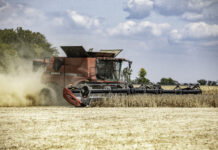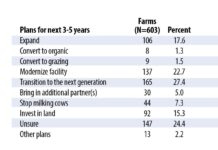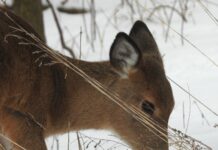
The bobolink is an odd bird. It has a song that sounds like the beloved Star Wars robot R2-D2. Males perform their mating displays in the air, complete with exaggerated, slow motion wing flaps. They look like they’re wearing a tuxedo, but backward.
“If George Lucas were making a decision on what an alien should sound like, it would be the bobolink,” said Andy Jones, William A. and Nancy R. Klamm, chair and curator of ornithology for the Cleveland Museum of Natural History in Cleveland.
Wait to mow
Perhaps because it’s such a character, the bobolink is extremely popular with bird watchers — so much so that it inspired a study at universities in Vermont, Connecticut and Rhode Island called The Bobolink Project, which in turn led to the “wait to mow” movement.
The populations of bobolinks and other grassland birds are declining, mostly because of loss of habitat, but also because farming methods have “intensified,” according to Allan Strong, a researcher with The Bobolink Project. Hay is now harvested early and often, with powerful disc mowers against which wildlife doesn’t stand much of a chance.
The bobolink’s population has declined about 75% in the last 40 to 50 years, Strong said in a talk called Bird on the Rebound that can be found on Youtube. The USDA has acknowledged the research at those New England universities and now recommends that farmers delay mowing at least some hay fields until after July 15 to save bobolinks and other grassland birds that nest in them — not to mention pheasants, rabbits, deer and other wildlife.
Those grassland birds include the Eastern meadowlark (related to the bobolink), savannah sparrow, grasshopper sparrow, sedge wren, upland sandpiper, Henslow’s sparrow and others that like to nest in “old” hay fields — fields that have been in hay for eight years or more. By then, they’ve accumulated a lot of dead vegetation that makes for good nesting material, and good cover, Jones said.
In this part of the country, we don’t see bobolinks until May, he said. They begin sitting on nests in early June. By late June, after just two weeks of incubation, the young start hatching. They’re in the nest for another 10 or 11 days, eating seeds, then adding grains and insects.
“The young start leaving the nest, but they can’t fly well, so they’re very susceptible,” Jones said. So the recommended date of July 15 is cutting it pretty close, no pun intended.
The USDA Natural Resources Conservation Service (NRCS) says if you can’t wait till July 15, do the first cutting before May 31, then wait 65 days before doing the second.
“This strategy may be used where farmers need some amount of high-quality forage, but are interested in higher production volume but lower quality late hay for dry cows or horses,” the agency said in a recent press release.
Agricultural practices
In a guide called Agricultural Practices That Conserve Grassland Birds, the NRCS says to avoid mowing after sunset because birds won’t flush after dark. And to slow down, because nesting birds can’t react in time to high-speed harvesters.
The National Audubon Society agrees, adding a recommendation to avoid mowing in a circular pattern, which can corral and trap birds in the center of the field. Instead, mow the field from the inside out. They also recommend attaching a flusher to the mower to give adult birds a better chance to escape. The good news is, even if they lose their first nest, adult grassland birds will often make a second.
The NRCS in Vermont now offers incentives to farmers who delay second cuttings. In its early years, The Bobolink Project got $64,000 in private donations to help 10 Vermont farmers practice grassland-bird-friendly management.
“We learned that people love bobolinks and are willing to pay the farmers directly to have them delay their cuttings so the bobolinks can successfully fledge young,” said Strong.
On 340 acres in Vermont, he and other researchers counted 128 females and 157 males.
“The typical birth rate on high-quality late-cut fields is two young per female, so they probably raised 250 bobolink on these fields, which is substantial,” he said. “I think we can make a difference, at least at the local level.”
Paris Township
Long before The Bobolink Project and USDA recommendations, Jim and Susan Crawford were making a difference on their Paris Township farm in Stark County. Fifteen years ago, they found a neighbor, Don Burger, who was brave enough to mow the hilly, 10-acre field that was formerly pasture for dairy cows. And he was willing to delay mowing because of the bobolinks that nested in the field.
“It’s my favorite bird because their song is almost as good as the wood thrush’s,” said Jim, who remembers taking his “city slicker” cousins to the field in 2008 and seeing seven males displaying in the air.
“I could literally time it,” he said. “On May 1, the males would arrive from South America.”
He figured out on his own that it would take until July 15 before their eggs hatched, and the young were ready to go. So that’s how long Burger waited to mow. Now the Crawfords are lucky to see one bobolink a year, Jim said. But there are still plenty of meadowlark, quail and the occasional pheasant that use the field for nesting.
University Farm
Ana Locci was also ahead of the curve when it came to delayed mowing. Case Western Reserve University owns 400 acres in Cuyahoga County’s Hunting Valley. It’s called University Farm, but it’s really more of a nature preserve and outdoor education area.
When Locci became director 20 years ago, the farm fields were mowed three or four times a year. It was not for commercial hay production — that ended 80 years ago — but just to keep them from getting out of control. She changed that schedule to once a year, in September or October, not only to help ground-nesting birds like the bobolink, but also bees.
University Farm currently has four hives. “The bobolink are gone by the end of July and August, but the bees still need the goldenrod for the pollen,” she said.
The result is that bobolink, meadowlark and other grassland dwellers are among the 80 species of birds that have been spotted on the farm at 37125 Fairmount Blvd. You can see them — and the residents of 58 bluebird houses that have been installed along one of the hiking trails — between 8:30 a.m. and 5 p.m.
World travelers
In addition to their quirky song and bizarre flight patterns, bobolinks have oddities related to the fact they cover more miles than almost any other migratory songbird — more than 10,000 miles a year, especially for those that go clear to Canada.
“The fall migration includes being out over the open ocean for a few days,” Jones said.
They leave the U.S., fly over the Caribbean, and then land to feed in dry, grassy areas of Venezuela and Brazil before continuing on to Argentina and Bolivia, he said.
All that flying wears out their feathers. So does sun and sharp vegetation. Perhaps that’s why bobolinks are the only birds to molt twice a year. And unlike other birds, they don’t just replace some of their feathers, they replace all of them.
In July and August, they lose what looks like the backward tuxedo, with black on the front and white and yellow on the back. In its place, they acquire more brown plumage to better camouflage themselves in the South American fields, Jones said. They molt again in late winter or early spring, before their trip north, This time they’re wearing the tuxedo in preparation for mating.
Rice bird
Another thing that makes bobolinks odd is their old name, “rice bird.”
Jones explained that in addition to their usual diet of insects, grains and seeds — including grass, wheat, barley and oat seeds — they eat rice.
Farmers in the deep South don’t think it’s cute when huge flocks land in their rice fields and chow down, Jones said.
As you’re reading this, he may be out looking for bobolink and whatever other birds he can see — or hear — in the annual Breeding Bird survey.
“I do the survey in part of Geauga County, and there are a few spots where I see bobolinks displaying,” Jones said.
But he must start the survey at 5:21 a.m., before daylight. Plus, most of the birds he is trying to count are hidden in trees or dense foliage. That means he has to be really good at identifying birds by their songs.
“I probably hear 90% of the birds I count without seeing them,” Jones said. In the case of the bobolink, he just has to listen for R2.













I have not seen a finch for two years now. what can be happening to them?
Mowing either early or late in the season not only benefits the grassland nesting birds and the bees, but also the Monarch butterflies. I live in metro-west Boston and have hand-reared Monarchs for 13 years and have a registered Monarch Waystation through MonarchWatch. I observe them in my yard as well as wild areas, and from what I’ve observed, their prime breeding season in this area is from July 1st through September 30th (with some outliers). Mowing before or after these dates allows most Monarchs to complete their life cycle in this area.
Mowing the fields is important because it keeps the invasive weeds and woody plants in check, which allows the milkweed to compete if not thrive. Mowing in early summer also tends to produce lots of fresh milkweed shoots and the female Monarchs love to lay eggs on fresh growth (even tiny shoots and seedlings).